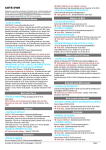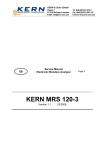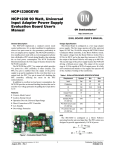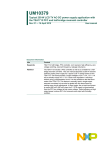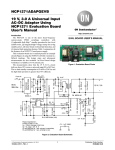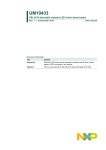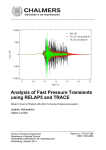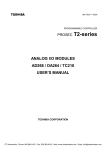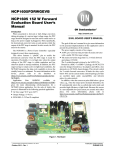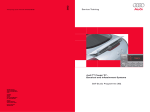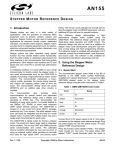Download EVBUM2124 - NCP1203GEVB A 70 W Low Standby Power Supply
Transcript
NCP1203GEVB A 70 W Low Standby Power Supply with the NCP120x Series Evaluation Board User's Manual http://onsemi.com EVAL BOARD USER’S MANUAL Introduction this level. Thanks to the natural secondary / auxiliary reflection, the primary auxiliary winding cannot maintain a sufficient voltage on the control IC: Vcc collapses and puts the controller in trouble, probably entering an hiccup mode, similar to that of a startup sequence. DSS being decoupled from Vout, you never see that phenomenon. As you can see, the DSS offers interesting features but, on the other hand, it can sometimes compromise key design parameters. Standby power and power dissipation are one of these: • Standby power: the DSS standby power contribution can easily be evaluated: VHV × Iavg with Iavg, the current consumption taken by the controller and VHV, the high−voltage supply rail. If Iavg equals 1 mA, then we have a standby power of 350 mW at a 350 VDC voltage rail. Tricks exist to slightly reduce it, like the half−wave diode, but you will only gain between 20–30%. • Power dissipation: as stated above, all the current consumed by the IC is seen through pin8. This is due to the self−adaptive feature of the DSS. Should the IC current move up or down, the DSS duty−cycle will automatically adjust to deliver it. The controller current depends on the internal IC consumption, but also on the type of MOSFET connected to the output. It therefore important to assess the total current drawn from the HV rail and checks the right compatibility with the package type. All details are given in the NCP1200 dedicated data sheet and the application note AND8023/D. As a result, the answer lies behind your design constraints. If you would like to have a precise Over Current Protection (OCP) trip point while driving a moderate size MOSFET, DSS can be a good choice, provided low standby power is not an absolute necessity. In our case, we want to drive a large MOSFET for a better efficiency but we need to reach the lowest possible standby power. We will thus adopt an auxiliary winding configuration to permanently disable the DSS. Solutions to various combinations of these constraints are described in the application note “Tips and Tricks for the NCP1200,” document number AND8069/D. The NCP1200 represents one of the cheapest solutions to build efficient and cost−effective Switch−Mode Power Supplies (SMPS). As this design example will show, the part definition does not confine the component in low−power applications only, but it can actually be used in Flyback and Forward supplies for virtually any output power. The below example depicts a universal mains 90−260 VAC power supply delivering 16.5 V @ 4.5 A. Beside its ease of implementation, the NCP1200 excels in true low standby power designs. This application note details how an amazing standby power of less than 100 mW can be reached at high line with a nominal 70 W board. DSS or Not DSS? The Dynamic Self Supply (DSS) lets you directly drive MOSFETs from the high−voltage rail. This option brings you several advantages, as stated below: • True overload detection: with UC384X−based systems, the switching oscillations are stopped in case the Vcc line drops below a given Undervoltage Lockout level (UVLO). This principle considers a good coupling between the primary auxiliary winding and the power secondary winding. Unfortunately, leakage elements often degrade this coupling and you only can detect true short−circuit (when Vout is close to zero) and not overload conditions. Thanks to the DSS, the NCP1200 does not need an auxiliary information to sense an overload condition. By detecting a current setpoint pushed to the maximum, the internal logic takes the decision to enter into a safe burst operation, auto−recovering when the default leaves. Precise overload levels can thus be implemented. • Guaranteed operation at low output levels: the Vcc delivered by an auxiliary winding moves with the power output level because a coupling exists between both windings. When the supply is used in battery charging applications, Vout can move depending on the charging state. That is to say, when the battery is nearly empty, its voltage can be close to zero, forcing Vout at www.BDTIC.com/ON/ © Semiconductor Components Industries, LLC, 2012 June, 2012 − Rev. 3 1 Publication Order Number: EVBUM2124/D NCP1203GEVB Figure 1. Evaluation Board Picture Self−Powering the Controller in Standby 1 An auxiliary winding does not usually cause any self−supply problem with a continuous pulses flow. In standby, whatever implemented frequency reduction techniques (e.g. skip or frequency foldback), the recurrence between pulses can become very low. By definition, the feedback loop manages to keep the energy content in each burst high enough to maintain the nominal output voltage. However, on the auxiliary side, it can be difficult to keep the Vcc above the controller’s UVLO. Remember, to permanently disable the DSS, you need to guarantee a level above VccON max. which is 11 V for the NCP1200. Failure to do this will re−activate the DSS in no−load conditions and standby power will be degraded. Figure 2 offers a view of a typical bunch of pulses captured in standby at a 127 VDC input voltage. 2 8 NCP1200 7 3 6 4 5 Rlimit 3 CVcc 1N4148 2 15 V Caux 1 Laux Figure 3. The Auxiliary Is Clamped to Avoid Exceeding the 16 V Maximum Rating As we previously stated, we want to deliver 70 W with a 16.5 V output level. The maximum rating for the NCP1200 states a level less than 16 V. As a result, the auxiliary Vcc shall be less than 16V but also above VccON in any conditions to ensure full DSS de−activation. A solution consists in artificially raising the ratio between the power winding and the auxiliary one to ensure adequate supply at no−load. We successfully tested a 0.9 ratio, where the auxiliary output gets clamped by a 15V Zener diode in nominal operation. Figure 3 shows the option. We measured a Vcc of 11.5 V @ 230 VAC and 12.2 V @ 90 VAC. Rlimit on Figure 3 can easily be adjusted to move these values up or down, depending on the final winding ratios. Care must be taken to avoid over−dissipation of the 15 V Zener diode in nominal conditions. 33 ms Power Supply, Element−by−Element Design 200 μs Let’s first detail the specs of our power supply: Vin: 90–265 VAC Vout: 16.8 V @ 4.2 A (Pout = 70 W) Short−circuit protection Over−voltage protection Efficiency > 80% Pin = 70 / 0.8 = 87.5 The below sequence details step−by−step the calculation procedure for every component of the power supply. Figure 2. A Bunch of Auxiliary Pulses Captured While the Supply Operates at No−Load (Vin = 127 VDC) www.BDTIC.com/ON/ http://onsemi.com 2 NCP1203GEVB DC High−Voltage Rail Diode Bridge Selection From these above numbers, we can deduce the level of the high−voltage rail, neglecting the dual Vf drop: To select the right rectifiers, it is necessary to know the RMS current flowing through its internal diodes. Prior to reach this final result, we need to evaluate the diode conduction time. From Figure 5, we can see that the diode starts to conduct when VACin reaches Vmin and stops when reaching Vinpeak: VHV max + 265 @ Ǹ2 + 374 VDC VHV min + 90 @ Ǹ2 + 127 VDC Vripple tc Vinpeak Vmin Vinpeak Vbulk VHVavg 10 ms 300 mA Idiode VAC in X−2 ms/div Figure 4. A Typical Ripple Voltage Over the Bulk Capacitor Figure 5. When VACin Reaches Vpeak, the Diode Stops Conducting From a mathematical point of view, we can calculate the time VACin takes to reach Vmin, with Vmin = Vpeak − Vripple: Bulk Capacitor Figure 4 portrays the typical waveform captured across a bulk capacitor delivering power to a given charge. To simplify the calculation, we will neglect the charging period and thus consider a total discharge time equal to 1/(2 ⋅ Fline). From the design characteristics, we can evaluate the equivalent current (Iload) drawn by the charge at the lowest input line condition. Let’s us adopt a 40% ripple level, or a 50 V drop from the corresponding Vinpeak. To evaluate the equivalent load current (which discharges Cbulk between the peaks), we divide the input power by the average rectified voltage: Iload + VACin @ sin(w @ t) + Vmin Since Vpeak is reached at the input sinusoid top (or one fourth of the input period), then the diode conducting time tc is simply: tc + [ 860 mA DC @ 90 VAC input voltage Ǔ (3) 360 @ Fline Qbulk + Vripple @ Cbulk + 9 mC Thanks to Figure 4 information, we can evaluate the capacitor value which allows the drop from Vpeak down to Vavg − (Vripple/2) to stay within our 50 V target, dV ⋅ C = iload ⋅ dt: Vripple 2 (4) From Figure 5, we can calculate the amount of charge Q drawn from the input by integrating the input current over the diode conduction time: (2) Pout 2 @ h @ Fline @ Vripple @ ǒVpeak * Vmin VACin@Ǹ2 During these 3 ms, Vbulk is the seat of a rising voltage equal to Vripple or 50 Vpp. This corresponds to a brought charge Q of: 2 Cbulk + ǒ sin −1 [ 3 ms @ Vin + 90 VAC (1) Pout Pin + Vripple Vrectavg ǒ Ǔ h @ Vpeak * 1 * 4 @ Fline tc Ǔ Qin + ŕ idiode(t).dt 0 w 171 mF or 180 mF for a normalized value The expression of idiode(t) is: (Fline = 50 Hz worse case). www.BDTIC.com/ON/ http://onsemi.com 3 (5) NCP1203GEVB Ipeak @ tc * t tc Turn Ratio and Output Diode Selection (6) The primary/secondary turn ratio affects several parameters: • The drain plateau voltage during the OFF time: the lowest plateau gives room for the leakage inductance spike before reaching the MOSFET’s BVdss: After proper integration, it comes: Qin + 1 @ Ipeak @ tc 2 If we now equate Qbulk and Qin and solve for Ipeak, it comes: Qbulk @ 2 Ipeak + tc Vplateau + (7) Irms + Ǹ Fline @ + Ipeak @ Ǹ ŕ (idiode(t))2 @ dt the turn ratio and the regulated output voltage by: PIV + Ns @ VinDC max ) Vout Np (8) (11) If you lower the plateau voltage, you will increase the reverse voltage the secondary diode must sustain. With these numbers in mind, you can tweak the turn ratio according to the MOSFET BVdss and the diode maximum reverse voltage. A Schottky diode represents a good choice, especially with a power supply that can possibly enter Continuous Conduction Mode (CCM). The lack of reverse recovery loss and a low forward drop play in favor of this component. However, because of the metal−silicon junction, moderate breakdown voltages are available for a moderate cost. The MBR20100 represents an interesting choice since it welcomes two 100 V Schottky in a TO−220 package. Being in thermal contact, a parallel wiring is possible. The 100 V VRRM lets us calculate the minimum turn ratio we can go down to, keeping an acceptable safety margin: 0 tc @ 2 @ Fline 3 + 1.9 A @ VAC + 90 We selected a KBU4J diode bridge (600 V/4 A) for the rectifying function. A small resistor, or best an NTC, can however be put in series to limit the surge current (when you plug the SMPS in the AC outlet) to less than the diode maximum peak current (Ifsm) or what the standard imposes you. Thanks to these numbers, we compute the apparent power at low line: 1.9 A × 90 V = 170 VA which compared to our 87.5 Watts of active power (neglecting the input diode bridge and Cbulk losses) gives a power factor of: PF + W + 0.51 V.A (10) • The secondary Peak Inverse Voltage (PIV) is linked to or 6 A peak. We can now evaluate the RMS current flowing through the diodes: tc Np @ (Vout ) Vf) ) VinDC max Ns N + PIV * Vout VinDC max (9) (12) → Np:Ns ≤ 1:0.221. A final ratio of 1:0.166 offers an adequate safety margin (Vreverse = 80 V max). The diode’s conduction power is evaluating using the following formula: conform to what we could expect from this kind of offline power supply. Transformer Calculation Transformer calculation can be done in several manners: a) you evaluate ALL the transformer parameters, electrical but also physical ones, including wire type, bobbin stack−up etc. b) you only evaluate the electrical data and leave the rest of the process to a transformer manufacturer. We will adhere to the latest option by providing you with a list of potential transformer manufacturers you can use for prototyping and manufacturing. However, as you will discover, designing a transformer for SMPS is an iterative process: once you freeze some numbers, it is likely that they finally appear either over or under estimated. As a result, you re−start with new values and see if they finally fit your needs. To help you speed−up the transformer design, a design−aid spreadsheet is available from the ON Semiconductor web site, www.onsemi.com/pub/NCP1200. Let’s start the process with the turn ratio calculation. Pdiodeavg + Vf @ Idavg ) Rd @ Idrms2 (13) Rather than manually calculating these numbers, we will see later on how a Spice simulator can do the job for us. Primary Inductance and Peak Current For AC/DC adapters delivering this amount of power in a small place, it is of common practice to make the power supply enter CCM in the middle of the total AC range (around 180 VAC in our case). When the input AC voltage diminishes, the on−time increases and the primary / secondary RMS current go up. This implies a greater heatsink for the MOSFET but also larger aluminum cans for the secondary filters. For this reason, a transition from Discontinuous Conduction Mode (DCM) to CCM will be envisaged here. Figure 6 depicts these different modes. www.BDTIC.com/ON/ http://onsemi.com 4 NCP1203GEVB Different methods exist to find the point transition takes place (also called the critical or borderline point). The idea consists in finding the critical inductance Lc that will make the supply enter CCM at 180 VAC. From Figure 6, we can write: ton + CCM L > Lc IL (14) Lp @ Ip VinDC Not 0 at turn ON IP Lp @ Ip toff + N @ (Vout ) Vf) (15) L = Lc ON 0 L > Lc DCM OFF IL(avg) 0 before turn ON BCM D/Fs 0 Dead−time time Figure 6. Depending on the Primary Current at Turn−On, the Supply Crosses Various Operating Modes 4.50 3.50 2.50 1.50 500M DRV CS 2 Radd1 R D 1 C Vramp 3 14.0 10.0 Rsense 6.00 2.00 Radd2 −2.00 150 10.0U Figure 7. A Very Simple Way to Generate a Ramp from a Square Wave Signal Ǹh @2Lp@ Pout @ FSW 70.0U 90.0U The numerical application gives a 484 μH inductance with a peak current of 2.36 A. The NCP1200 incorporates a skip−cycle feature that forces the controller to slice the switching pattern when the power supply drives light loads. Depending on the system time constants, the recurrence of the burst can enter the audible frequency range. Since the default skip−cycle takes place at one third of maximum peak current, it is better to avoid working at high peak current in normal operation. Should noise still appear in skip mode, pin1 lets you select a different lower skip level (unfortunately to the detriment of the standby power) generating less mechanical noise. As a result, we slightly increased the primary inductance to 700 μH to further limit the noise in standby operation. (16) Ip = primary peak current N = Np / Ns = 1/0.166 = 6 Pout = output power η = efficiency Lp = primary inductance Fsw = switching frequency Vf = secondary diode forward drop VinDC ≈ Vac ⋅ Ǹ2 (neglecting ripple) Combining equations 14, 15 and 16 we obtain an Lp value to be in BCM at 180 VAC input voltage: Lp + 50.0U Figure 8. Simulations Show a Capacitor Voltage Ramping Up from a Few Hundred of mV Up to Nearly 5 V From the Flyback formula, we obtain: Ip + 30.0U (Vout2 ) 2 @ Vout @ Vf ) Vf2) @ (eff @ N2 @ Vin2) (17) [Pout @ [(N @ Vout ) N @ Vf ) Vin)2 @ FSW]] @ 2 www.BDTIC.com/ON/ http://onsemi.com 5 NCP1203GEVB Once reflected over Rsense, it becomes: 50.5 mV / μs (S’) Duty−cycle in CCM: MOSFET Selection The MOSFET drain voltage sees, in normal operation, a maximum voltage of: VinDC max ) (Vout ) Vf) @ N ) Ip @ Lleak ǸClump D+ (18) From Figure 7 network, the maximum voltage is given by R and Radd1 + Radd2. With a 11 V driving voltage delivered by the NCP1200, we recommend a 18 kΩ for R and 1 nF for C. These values offer an acceptable tradeoff in terms of power consumption but also in terms of noise immunity. The corresponding time constant of 18μs gives a ramp maximum peak voltage of: The first term represents the maximum rectified DC voltage and goes up to 375 V. The reflected voltage pushes further up by 101 V. Summing up these levels gives a total steady−state drain voltage of 476 V. The last term in equation 18 depicts the leakage inductance action which further stresses the MOSFET at the opening. If we select a 600 V device, it leaves more than 100 V for this leakage action. A clamping network will stop its rise anyway. A 2SK2843 from Toshiba can be a good choice. This is a TO−220 600 V 10 A component which features a 1.2 W RDS(ON) @ Tj = 100°C. 1 Vcc + Vdrv @ ǒ1 * e t Ǔ + 5 V (21) with t = 0.45 × 1/61 k. This provides an available ramp level of 677 mV/μs (S). By setting Radd2 to 1 kΩ, Radd1 can be computed using the following formula: Ramp Compensation Radd1 + 1 k @ With a supply entering CCM together with a duty−cycle greater than 50%, we need to inject ramp compensation into the controller to prevent subharmonic oscillations. An easy way to generate a ramp, is to take the driving signal available from pin5 and integrate it through a RC network. Figure 7 shows how to wire the components and Figure 8 shows the signal obtain with a 18 kΩ / 1 nF RC time constant. To calculate the necessary amount of ramp m, several methods exist. We will stick to the standard one which consists in injecting between 50 and 75% of the off−time downslope. The calculation is as follow: Primary off−slope: N @ (Vout ) Vf) + 153 mAńms Lp (20) Vout + 45% @ Vin + 120 VDC N @ Vin ) Vout S + 22.5 kW SȀ @ m for m = 60%. Final tweak gives an 18 kW resistor for Radd1. Component Constraints In this section, we will see how Spice can help us to precisely determine all the component constraints and thus calculate the necessary amount of heatsink they need. The simulation schematic we adopted is given on Figure 9 and shows the NCP1200 wired as recommended in the data sheet. Please note that the simulation fixture has been simplified to allow faster simulation time. For instance, the TL431 and its network usually hamper the simulation time to find out the right operating point. A Zener diode and a resistor help finding it in a much quicker way. (19) www.BDTIC.com/ON/ http://onsemi.com 6 NCP1203GEVB hv + R3 200 m 7 4 15 Istartup Vadj 1 2 21 Δ C3 100 nF Iripple1 Lleak 12 μH Iclp 6 4 5 + 10 NCP1200 Fs = 65 k Vout Rload 3.7 32 C2 220 μF IC = 16.5 R15 1.0 k Idrain 19 8 Rg Vcc drv 10 5 Iripple2 9 Vdrain 7 3 Vout 17 Resr2 300 m C1 3.3 mF IC = 16.5 d 8 NCP1200 Isec D4 MUR160 12 31 Resr1 11 m Lp 700 μH 24 + + Vinput 120 R2 4.7 k R10 10 m 1 Iprim Vclamp Iout Vsec X6 L1 MBR20100 100 μH + X1 XFMR RATIO = −0.166 X5 SFH610A 20 Drv 14 R8 1.0 k R5 100 m R10 18 k D1 1N4148 18 D3 1N963 Vsense R9 18 k 16 Cvcc 47 μF IC = 14 23 C6 1.0 nF Rsense 0.33 VFB Figure 9. The Simplified Simulation Schematic Helps to Determine All the Component Key Parameters www.BDTIC.com/ON/ http://onsemi.com 7 NCP1203GEVB 1 Idrain 2 Iprim 3 Iripple1 4 VCLAMP RMS = 1.10 amps between 2.05 M and 2.06 M secs 3.00 2.00 1.00 1 0 −1.00 RMS = 1.53 amps between 2.05 M and 2.06 M secs 2.40 2 2.00 1.60 1.20 800 M RMS = 4.65 amps between 2.04 M and 2.05 M secs 10.00 6.00 3 2.00 −2.00 −6.00 y (mean) = 152 volts x (first) = 2.00 M secs 156 154 4 152 150 148 2.01 M 2.03 M 2.05 M 2.07 M 2.09 M Figure 10. Complete Simulation Results of the 70 W Converter Operated at 120 VDC Input Voltage Important results appear in Figure 10. Please note that the maximum RMS current occur at the lowest line where the duty−cycle is pushed to the limit. As you can see, the ramp compensation works fine and no subharmonic oscillations can be noted. Once everything is extracted, below are summarized the most important design constraints: Lower Rθheatsink−air resistances can of course be selected to run the device cooler. Diode The MBR20100 welcomes two diodes that share nearly equal current thanks to their equal forward drops. The total forward drop dissipation will remain the same but the RMS losses sensitive to the dynamic resistance will divide by two: IRMS total = 6.8 A IAVG total = Iout = 4.2 A Rd @ 3.4 Arms = 27 mΩ Vf @ 2.2 Aavg = 0.7 V Pcond for one diode = 3.42 × 0.027 + 2.2 × 0.7 = 1.85 W or 3.7 W for the whole TO−220 package. Simulations gives a bit less to 3.4 W. Heat calculations (Tj < 100°C and 50°C ambient) recommend a heatsink of 8°C/W for the MBR20100. As stated before, lower Rθheatsink−air resistances can of course be selected to run the device cooler. MOSFET Rdson @ 100°C = 1.2 ohms RthetaJC = 2.8°C/W Pcond = 1.2 * 1.12 = 1.5 W The conduction losses are the strongest at low line. The total simulated losses, including switching events are evaluated to be around 2.6 W. Further breadboard measurements confirmed this number. If we want to keep the junction temperature around 100°C at an ambient of 50°C, then we shall add a proper heatsink according to the following calculation: Rqheatsink−air + (Tj max * Tamb max) P Capacitors Icapacitor RMS = 5 A The paralleling of capacitors will help achieve the right ripple current shared between all the devices. We selected three 2.2 mF capacitors capable of handling 1.7 Arms each. * RqJunction−Case * RqCase−Heatsink [ 15° CńW www.BDTIC.com/ON/ http://onsemi.com 8 NCP1203GEVB Transformer network analyzer and confirms the validity of our approach (Vin = 240 VAC). Stability has been checked at various line/loads combinations and gave good results. Final transient step did not reveal any overshoot or unwanted oscillations. Below are the key parameters you will pass to your transformer manufacturer to help him select the right winding size and tailor the internal gap: Maximum peak primary current, including 160 ns propagation delay: 1 / 0.33 + 374 × 160 n / 700 μ = 3.2 A Maximum primary RMS current at low line: 1.6 A Maximum secondary RMS current: 6.9 A Primary inductance: 700 μH Turn−ratio, power section: Np:Ns = 1:0.166 Turn−ratio, auxiliary section: Np:Naux = 1:0.15 The Adapter Schematic The final schematic implements a current−mode Flyback architecture, driving a 600 V MOSFET. The 2SK2545 features a 10 A capability but a 6.0 A/600 V can also be mounted, such as the FQP6N60 from Fairchild but to the expense of increased conduction losses. Figure 14 offers a complete view of the electrical sketch. The board can actually be used with either auxiliary or without auxiliary winding. By removing the resistance R4, you reactivate the DSS on a NCP120X controller featuring this ability. The board can therefore accept the following controllers: NCP1200, featuring DSS. NCP1200A, featuring DSS. NCP1203, auxiliary winding only. NCP1216, featuring DSS and internal ramp compensation. Improved EMI jittering with DSS. NCP1217, auxiliary winding only, internal ramp compensation. On NCP1216 and 1217, the internal ramp compensation avoids using the external circuitry made of R1−R7−D4 and C10. If one of these two parts are plugged in the demoboard, you must disable this network by simply disconnecting R1 and growing R6 up to 2.7 kΩ (for a 65 kHz operation). The NCP120X takes place with two other bipolars that implement a discrete SCR, activated in presence of an OVP, e.g. an optocoupler failure. D5 senses the overvoltage condition and can easily be adjusted to fit any other levels. Thanks to R10, the OVP permanently latches−off the supply and the user shall cycle VCC off and on again to restart the supply. Shutdown is obtained by pulling the feedback pin down through D6. The clamp resistor is split in two different components to avoid an excessive heat burden on one single device. Both main MOSFET and secondary diode are mounted on an adequate heatsink to evacuate the heat. To ease the designer task, or simply help evaluating the board performance faster, we have experimented different transformers, available through Appendix B manufacturers. Please note that some include the auxiliary winding for DSS deactivation whereas other only offer a dual winding arrangement where the DSS no longer activates and offers the best standby power. All details are given in appendix B. The final demoboard will not accommodate with all these transformers simply because multiple footprints was not possible. They however have all been tested okay. Measurements were taken with the Coilcraft transformer. As a final note, the actual demoboard delivers 19 VDC/70 W versus the original design−based 16.5 V. As a result, figure 1b circuit has been replaced by L3−R13 and C12 to improve the short−circuit protection when using an auxiliary winding. Output voltage can be adjusted by changing the feedback network made of R12/R20/R21. Clamping Network The clamping network can be calculated using the following formulae: (22) Rclamp 2 @ Vclamp @ (Vclamp * (Vout ) Vf sec) @ N) + Lleak @ Ip2 @ FSW Cclamp + Vclamp Vripple @ FSW @ Rclamp (23) The power dissipated by Rclamp can also be expressed by: PRclamp + 1 @ Lleak @ Ip2 @ FSW @ 2 (24) Vclamp (Vout)Vf sec)@N Vclamp (Vout)Vf sec)@N *1 with: Vclamp: the desired clamping level; Ip: the maximum peak current (e.g. during overload); Vout + Vf: the regulated output voltage level + the secondary diode voltage drop; Lleak: the primary leakage inductance; N: the Ns:Np conversion ratio; Fsw: the switching frequency; Vripple: the clamping ripple, could be around 20 V. With a measured leakage inductance of 12 μH and a final clamping level of 150 V, Rclamp is found to be 4.7 kΩ/6 W and Cclamp 100 nF. The RMS current flowing through Cclamp is 220 mA. RC networks are economical clamping devices and care must be taken to not exceed the MOSFET BVdss in the most stringent conditions, e.g. a cold startup sequence at high line. Worse case arises when Ip is maximum and Vout reaches the target. Stability Analysis The stability analysis can be investigated using different approaches. Spice has proven to be rather accurate for feedback loop analysis with SMPS. We will use the NCP1200 average model which is available to download from our web site (www.onsemi.com/pub/ncp1200). Figure 11 shows the simulation template where the feedback network on the TL431 has been simplified to a simple 100nF capacitor. Thanks to average modeling, the simulation time is kept short and results are delivered in a snap−shot, as testified by Figure 12. Figure 13 unveils the results obtained using a www.BDTIC.com/ON/ http://onsemi.com 9 NCP1203GEVB CTRL 2.93 340 Vin 1 + Vin 350 OUT 11 CoL 1.0 kF 4 17.5 Resr1 30 m 16.9 X1 NCP1200_Av FS = 61 k L = 700 μ MC = 39605 RI = 0.33 + 2.93 16.8 7 Rload 4.2 9 C2 100 μF out2 16.1 5 R5 4.7 k 15.4 Rupp 39 k C1 100 nF 10 C5 1.0 nF 16.8 R15 1.0 k X3 SFH610A 15 R17 300 m C1 5.8 mF out1 Vout out2 16.8 16.9 12 LoL 1.0 kH 0 14 VStim AC = 1 2 FB GND Rs 10 m + NCP1200 averaged IN Iout D1 X1x MBR20100CT out1 L1 XFMR 10 μH 105 RATIO = 0.166 16.9 2.50 X5 TL431 13 Rlow 6.8 k Figure 11. The Simulation Schematic for Our 70 W Current−Mode Power Supply Mag (dB) 48.0 160 Phase 24.0 80.0 48.0 160.0 36.0 120.0 24.0 0 −12.0 −80.0 −48.0 −160 0 10 1k 10 k 40.0 0 0 −24.0 80.0 Phase 12.0 Gain 0 Phase (deg) −40.0 Mag −24.0 −80.0 −36.0 −120.0 −48.0 −160.0 100 k 10 Figure 12. Simulated Bode Plot of the Current Mode Flyback 100 1k 10 k 100 k Figure 13. Measured Open−Loop Gain with a Network Analyzer www.BDTIC.com/ON/ http://onsemi.com 10 Figure 14. The Simulation Schematic for Our 70 W Current−Mode Power Supply www.BDTIC.com/ON/ http://onsemi.com 11 Universal Input 2.2 R2 5 W, fuse type R3 1M C2 X2 470 nF 2 × 27 mH L2 B1 2KBP08M C3 220 μF + 2N2222 Q2 R8 10 k 2N2907 Q1 R5 10 k OVP (optional) C11 10 nF C23 1.0 nF* D6 BAT54 D5 27 V Vcc 6 Drv 5 3 CS 4 GND R1 18 k Ramp Comp if needed C24 47 μF 7 2 FB R6 1.0 k * HV 8 IC3 R10 12 k 1 Adj * = Close to the IC + R1A 39 k + C10 1.0 nF R1B 39 k L3 47 μH D1 MBR20100 + + C5 C6 C7 + C25 2.2 nF Y1 type IC1 SFH6156−2 M1 FQP6N60 IC2 TL431 C8 open L1 10 μH R11 1.0 k R18 1.0 k 2200 μF Lp = 700 μH T1 1:0.15 for Np:Ns_aux 1:0.166 for Np:Ns_power 3 × 1 W SMD // R7A, B, C 0.33, total 1 W D4 1N4148 R9 47 D2 C12, 10 nF R13 1.5 k D3 1N4148 D8 MUR160 D9 15 V R7 18 k C4 100 μF R4 220 C1 100 nF 2 × 39 kW 3 W in // R20 10 k R12 27 k R21 5.6 k C9 100 nF GND C220 220 μF R19 open + 19 V @ 3.6 A NCP1203GEVB 16.740 16.765 16.735 16.760 16.755 16.730 Output Voltage (V) Output Voltage (VDC) NCP1203GEVB 16.725 16.720 16.715 16.710 240 VAC 16.745 110 VAC 16.740 16.735 16.730 16.725 16.705 16.700 100 16.750 16.720 120 140 160 180 200 Input Voltage (VAC) 220 16.715 240 Figure 15. Line Regulation Is Excellent Thanks to Current Mode and a Good Open−Loop DC Gain 0 20 40 Output Power (W) 60 80 Figure 16. Load Regulation at Two Different Input Voltages Board Final Results Efficiency We have designed two boards, one using the auxiliary winding for best standby performance, and another one with the Dynamic Self−Supply (DSS) left normally working. Because of the auxiliary winding, it has been necessary to further clamp the drain voltage in order to improve the primary overload detection. It is not necessary with the DSS and therefore the RCD drain clamp network can be less aggressive, thus slightly improving the efficiency. Board 2 also features a 6 A MOSFET compared to a 3 A MOSFET on board 1. Board 1, aux. winding: Vin = 110 VAC, η = 79% Vin = 240 VAC, η = 83.5% Board 2, DSS: Vin = 110 VAC, η = 83.4% Vin = 240 VAC, η = 84.8% Standby Power Measured on an Infratek watt−meter operated in Watt−hour accumulation mode for best accuracy (run length = 30 minutes). Vin = 120 VAC, Vout = 16.76 V, Iout = 0 → Pin = 78 mW Vin = 240 VAC, Vout = 16.76 V, Iout = 0 → Pin = 84 mW Line Regulation The array in Figure 15 shows the performance when the input voltage is moving between both range ends. As one can see, current mode control with good open−loop gain ensures a ΔVout less than 1 mV for a 212 VDC input variation (−106 dB DC audio susceptibility). Load Regulation By varying the load current between 11 W and 70 W, it is possible to plot the load regulation of the board as shown in Figure 16. www.BDTIC.com/ON/ http://onsemi.com 12 NCP1203GEVB TEST PROCEDURE Figure 17. Test Setup Required Equipment • • • • Test Procedure 1. Connect the test setup as shown above. 2. Apply an input voltage, 85 Vac < Vin < 265 Vac, 50 or 60 Hz 3. Connect electronic load on output connector. ac power supply, 85 − 265 Vac, 1 A Electronic load, 19 V up to 4 A Yokogawa power meter WT210 Multimeter Table 1. DESIRED RESULTS Measurements Conditions Results 1 Output Voltage Vin = 100 Vac no load Vout = 19 V ±5% 2 Input consumption at high line and no load Vin = 230 Vac no load Pin = 0.09 W ±15% Vout = 19 V 3 Output voltage at high line and full load Vin = 230 Vac Iload = 3.6 A Vout = 19 V ±5% 4 Output voltage at low line and full load Vin = 85 Vac Iload = 3.6 A Vout = 19 V ±5% Comments No load measurement can fluctuate, run WT210 in average mode www.BDTIC.com/ON/ http://onsemi.com 13 NCP1203GEVB Appendix A, Bill of Material All resistors are 5% 1/4 W SMD 1206 unless otherwise noted. All SMD capacitors are 1206 SMD 16 V types unless otherwise noted. All through−hole electrolytic capacitors are radial types unless otherwise noted. Manufacturer references are given for specific components only. Table 2. BILL OF MATERIALS Designator QTY Description R1,R7 2 Chip Resistor Manufacturer Manufacturer Part Number Substitution Allowed RoHS Compliant 1206 Vishay CRCW120618KJN Yes Yes Value Tolerance Footprint 18 kW, 0.25 W 5% R2 1 Fusible Resistor 2.2 W, 5W 10% Axial Vishay CP00052R2JE14 Yes Yes R1A,B 2 Power Leaded Resistor 39 kW, 3.0 W 2% Axial Vishay PR030203902G Yes Yes R3* 1 Chip Resistor 1.0 MW, 0.25 W 5% 1206 Vishay CRCW12061M0JN Yes Yes R4 1 Chip Resistor 220 W, 0.25 W 5% 1206 Vishay CRCW1206220RJN Yes Yes R5,R8, R20 3 Chip Resistor 10 kW, 0.25 W 5% 1206 Vishay CRCW120610KJN Yes Yes R6, R11 2 Chip Resistor 1.0 kW, 0.25 W 5% 1206 Vishay CRCW12061K0JN Yes Yes R7A, B, C 3 Chip Resistor 1.0 W 1.0 W 5% 1218 Vishay CRCW12181R0JN Yes Yes R9 1 Leaded Resistor 47 W, 1/3 W 1% Axial Vishay CCF5047RFKE36 Yes Yes R10 1 Chip Resistor 12 kW, 0.25 W 5% 1206 Vishay CRCW120612KJN Yes Yes R12 1 Leaded Resistor 27 kW, 1/3 W 5% Axial Vishay CCF5027KJKE36 Yes Yes R13 1 Chip Resistor 1.5 kW 5% 1206 Vishay CRCW12061K5JN Yes Yes R18 1 Leaded Resistor 1.0 kW, 1/3 W 1% Axial Vishay CCF501K0FKE36 Yes Yes R19* 0 Not Installed - - - - - - - R21 1 Chip Resistor 5.6 kW, 0.25 W 5% 1206 Vishay CRCW12065K6JN Yes Yes C1 1 Polyester Film Capacitor 100 nF, 400 V 10% pitch: 15 mm Vishay 2222-373-53104 Yes Yes C2 1 Class X2 Suppression Capacitor 470 nF / X2 10% pitch: 27.5 mm Vishay F1772-447-20 Yes Yes C3 1 Aluminum Snap-In Capacitor 220 uF, 400 V 20% Radial Vishay 2222-157-46221 Yes Yes C4 1 Aluminum Capacitor 100 uF, 35 V 20% Radial Panasonic ECA1VM101 Yes Yes C5 -7 3 Aluminum Capacitor 2200 uF, 35 V 20% Radial Vishay 2222-136-50222 Yes Yes C8* 0 Not Installed - - - - - - - C9 1 Ceramic Chip Capacitor 100 nF, 16 V 10% 1206 Vishay VJ1206Y104KXJAT Yes Yes C10, C23 2 Ceramic Chip Capacitor 1.0 nF, 16 V 10% 1206 Vishay VJ1206Y102KXJAT Yes Yes C11, C12 2 Ceramic Chip Capacitor 10 nF, 16 V 10% 1206 Vishay VJ1206Y103KXJAT Yes Yes C22 1 Electrolytic Capacitor 470 uF, 35 V 20% Radial Panasonic ECA1VM471 Yes Yes C24 1 Electrolytic Capacitor 47 uF, 25 V 20% Radial Panasonic ECEA1EN470U Yes Yes C25 1 Ceramic AC Capacitor, Y1 2.2 nF, 500 V 20% Disc Vishay WKP222MCMBFOK Yes Yes B1 1 Diode Bridge 600 V-4.0 A NA NA Vishay KBU4J Yes Yes D1 1 20 A, 100 V NA TO 220 3 ON Semiconductor MBR20100CTG No Yes D2-4 D5A Schottky Rectifier 3 1N4148 Diode 75 V, 150 mA NA DO-35 Diodes Inc. 1N4148DICT-ND (Digi-Key) Yes Yes 1 Zener Diode 27 V, 500 mW NA SOD-122 ON Semiconductor MMSZ27T1G No Yes www.BDTIC.com/ON/ http://onsemi.com 14 NCP1203GEVB Table 2. BILL OF MATERIALS Designator QTY Description D6 1 Schottky Barrier Diode Value Tolerance Footprint 30 V, 200 mA NA DO-35 Manufacturer ST Microelectronics Substitution Allowed RoHS Compliant 497-2495-1-ND (Digi-Key) Yes Yes Manufacturer Part Number D8 1 Ultrafast Rectifier 1A, 600 V NA Axial ON Semiconductor MUR160G No Yes D9A 1 Zener Diode 15 V, 500 mW NA SOD-123 ON Semiconductor MMSZ15T1G No Yes IC1 1 Optocoupler 5300 Vrms IC2 1 Programmable Precision Reference 2.5 - 36 V IC3 1 Flyback BWM Controller NA Q1 1 PNP Silicon Plastic Transistor NA Q2 1 NPN Amplifier Transistor NA L1 1 Inductor L2 1 Current-Compensated Double Choke L3 1 Molded Axial Inductor 47 uH, 110 mA M1 T1 1 1 Heatsink 1 1 Heatsink 2 1 NA SMD-4 Vishay SFH6156-2 Yes Yes 2.2% TO-92 ON Semiconductor TL431ILPG No Yes NA PDIP ON Semiconductor NCP1200P60G No Yes NA TO-92 ON Semiconductor P2N2907AG No Yes NA TO-92 ON Semiconductor P2N2222AG No Yes 10 uH, 5 A 10% NA Coilcraft PCV-2-103-05 Yes Yes 2 x 27 mH, 1.4 A 30% NA EPCOS B82724-A2142-N1 Yes Yes 10% Axial Vishay IM02EB470K Yes Yes Toshiba 2SK2543 Yes Yes Power MOSFET 500 V, 8 A NA TO-220N IS Flyback Transformer 0.7 mH 10% NA Coilcraft Z9260-AL or Z9007-BL No Heatsink SW (diode) NA NA NA SeifertElectronic KL194/38,1 Yes Yes Heatsink SW (MOSFET) NA NA NA SeifertElectronic KL195/38,1 Yes Yes *Not Installed www.BDTIC.com/ON/ http://onsemi.com 15 Yes NCP1203GEVB Appendix B, Transformer Manufacturers Thomson Multimedia − Orega Route de Noiron B.P. 24 70101 GRAY Cedex − France Tel : 33 (0)3 84 64 54 26 Fax: 33 (0)3 84 65 18 45 www.thomsonmultimedia.com Email: [email protected] Ref. : G7086−01, no aux. winding, P = 70 W Eldor Corporation Headquarter Via Plinio 10, 22030 Orsenigo (Como) Italia Tel. : +39−031−636 111 Fax : +39−031 636 280 [email protected] www.eldor.it ref. : 2074.5059A, no aux. winding, P = 70 W Pulse Engineering Site d’Orgelet Zone industrielle 39270 − ORGELET Tel. : 33 (0)3 84 35 04 04 Fax: 33 (0)3 84 25 46 41 http://www.pulseeng.com/ Email: [email protected] ref. : PF0082, with auxiliary winding, P = 50 W ref. : PF0091, without auxiliary winding, P = 50 W Coilcraft 1102 Silver Lake Road Cary, Illinois 60013 USA Tel: (847) 639–6400 Fax: (847) 639–1469 Email: [email protected] http://www.coilcraft.com ref. : Z9260−A, with auxiliary winding, P = 70 W ref. : Z9007−B, without auxiliary winding, P = 70 W For Lower Volumes: Atelier Special de Bobinage 125 cours Jean Jaurès 38130 ECHIROLLES − France Tel. : 33 (0)4 76 23 02 24 Fax: 33 (0)4 76 22 64 89 Email: [email protected] Ref. : NCP1200–35 W–UM, no aux. winding, RM10 P = 35 W ON Semiconductor and are registered trademarks of Semiconductor Components Industries, LLC (SCILLC). SCILLC owns the rights to a number of patents, trademarks, copyrights, trade secrets, and other intellectual property. A listing of SCILLC’s product/patent coverage may be accessed at www.onsemi.com/site/pdf/Patent−Marking.pdf. SCILLC reserves the right to make changes without further notice to any products herein. SCILLC makes no warranty, representation or guarantee regarding the suitability of its products for any particular purpose, nor does SCILLC assume any liability arising out of the application or use of any product or circuit, and specifically disclaims any and all liability, including without limitation special, consequential or incidental damages. “Typical” parameters which may be provided in SCILLC data sheets and/or specifications can and do vary in different applications and actual performance may vary over time. All operating parameters, including “Typicals” must be validated for each customer application by customer’s technical experts. SCILLC does not convey any license under its patent rights nor the rights of others. SCILLC products are not designed, intended, or authorized for use as components in systems intended for surgical implant into the body, or other applications intended to support or sustain life, or for any other application in which the failure of the SCILLC product could create a situation where personal injury or death may occur. Should Buyer purchase or use SCILLC products for any such unintended or unauthorized application, Buyer shall indemnify and hold SCILLC and its officers, employees, subsidiaries, affiliates, and distributors harmless against all claims, costs, damages, and expenses, and reasonable attorney fees arising out of, directly or indirectly, any claim of personal injury or death associated with such unintended or unauthorized use, even if such claim alleges that SCILLC was negligent regarding the design or manufacture of the part. SCILLC is an Equal Opportunity/Affirmative Action Employer. This literature is subject to all applicable copyright laws and is not for resale in any manner. PUBLICATION ORDERING INFORMATION LITERATURE FULFILLMENT: Literature Distribution Center for ON Semiconductor P.O. Box 5163, Denver, Colorado 80217 USA Phone: 303−675−2175 or 800−344−3860 Toll Free USA/Canada Fax: 303−675−2176 or 800−344−3867 Toll Free USA/Canada Email: [email protected] N. American Technical Support: 800−282−9855 Toll Free USA/Canada Europe, Middle East and Africa Technical Support: Phone: 421 33 790 2910 Japan Customer Focus Center Phone: 81−3−5817−1050 ON Semiconductor Website: www.onsemi.com Order Literature: http://www.onsemi.com/orderlit For additional information, please contact your local Sales Representative www.BDTIC.com/ON/ http://onsemi.com 16 EVBUM2124/D

















